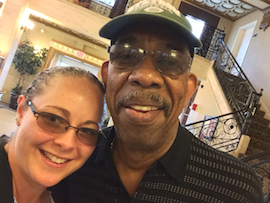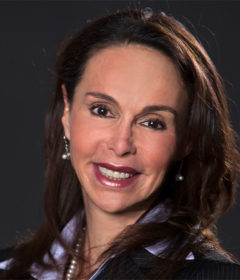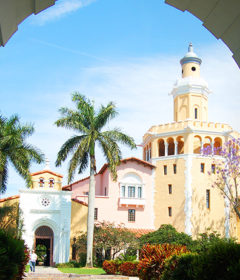Walking in the Steps of a Freedom Rider


At one point or another we all study the Civil Rights Movement – generally for a class period or two in our U.S. history class in high school. For those of us who are interested enough, we spend time delving into the history of the movement during our undergrad years and then, if we’re really lucky, we read a book or an article here or there as we get older. But for the men and women that my classmates and I met on this incredible journey we recently took, they lived it. They were the movement. In the unforgettable words of Betty White Strong Boynton: “I was a foot soldier. I am a foot soldier.”
We began our journey in Nashville, where we were joined by a great orator and Student Nonviolent Coordinating Committee Freedom Rider, Ernest “Rip” Patton. SNCC was the student-based organization that Rip was introduced to by a “Fisk girl” he was interested in. Rip was a student at Tennessee State University (f/k/a Tennessee A&I College) at the time. Rip’s interest in the movement may have begun because of a girl, but it continued because of him.
While in Nashville, Rip introduced us to four of his Freedom Rider friends who were all students at Tennessee State at the same time as him. While listening to these incredible individuals, one of the comments that stuck out the most to me was when they talked matter-of-factly about writing out their wills the night before getting on the busses in Alabama. The Congress of Racial Equality was ready to end the Freedom Rides, but SNCC and the Southern Christian Leadership Conference, led by Dr. Martin Luther King Jr., was not. The Freedom Riders knew the dangers, as did the leaders, and they were willing to do what it took to try to change the status quo of this country. Even understanding the power that the Freedom Rides would have, Matthew Walker Jr. of the SNCC vividly remembers saying to Dr. King, “Martin, we don’t want you on the bus. You’re too valuable.”

The Freedom Rides themselves came on the heels of the Supreme Court’s decision in Boynton v. Virginia, a monumental decision that struck down segregation in a restaurant that was deemed interminably linked with an interstate bus terminal and therefore interstate commerce. The Freedom Rides were to be a nonviolent demonstration of the constitutional ability to interstate travel and commerce. While our group was in Selma, we met Bruce Boynton – the named plaintiff in this monumental case. Upon hearing his familial background, it became clear to the class that making his case was more a way of life for Boynton than a one-time fluke. Boynton’s own mother was well-documented as being beaten until near-death on what became known as ‘Bloody Sunday’ – a first attempt at a peaceful march from Selma to Montgomery across the Edmund Pettus Bridge. The marchers were met with brutality by the Alabama State Troopers both on foot and on horseback. There were batons and teargas – the police were wearing gas masks. The outcry against Governor George Wallace and Alabama came from across the South, as well as the country.
‘Bloody Sunday’ did not mark the end of the attempt to march. There were many backroom deals and negotiations going on to try to make this march come to fruition. There was, and is to this day, much frustration with the leaders of the SCLC in how the full march was prolonged. ‘Turnaround Tuesday,’ as it became known, was a symbolic march across the Edmund Pettus Bridge. The leaders of the movement chose to turn the marchers around when the police confronted them because they knew that they would be in the legal wrong in going up against the police this time. Many of the marchers were upset and disheartened by this appearance of cowardice. We heard about this from Betty White Strong Boynton when she described her experiences to us as a teen involved in the Selma marches.
One month and four days after the original march day, the third, and final, march from Selma to Montgomery actually began. It took the marchers five days, but they made it to their final destination – the capitol building in Montgomery . Later that day/night, marchers were taken back to Selma by cars driven by different volunteers. This is when a white woman, and mother of five, from Detroit was assassinated by local Klansmen for assisting the movement . Her name: Viola Liuzzo. Mrs. Liuzzo was one of three deaths that came about during the Selma crisis.
One of the aspects of this trip that stuck with me the most was that in meeting all of the people that we met, every single one of them said something along the lines of “bitterness kills the soul.” These particular words came from Anthony Hinton – a man who spent 30 years on death row “because [he] was born black.” Mr. Hinton was introduced to our group by the Equal Justice Initiative who exonerated him. Mr. Hinton may be struggling with demons unimaginable to the rest of us who have never been in his shoes, but he can still look upon his experience without a bitterness that many a lesser human being would be unable to. “I met some of the nicest, caring people…and I never would’ve met them if I hadn’t been on death row,” Hinton told our group. There is a lesson to be learned from this man’s tragic experience.
The biggest mistake that any of us can make upon reading this or studying the movement is to think that it is in our past. The movement is not over. It will not end as long as there is bigotry and hatred in any form in people. The movement may change, it will evolve with the needs of the time, but it will not end. We can all be foot soldiers in the movement towards positive change.
This article originally appeared on the Stetson Law website.



